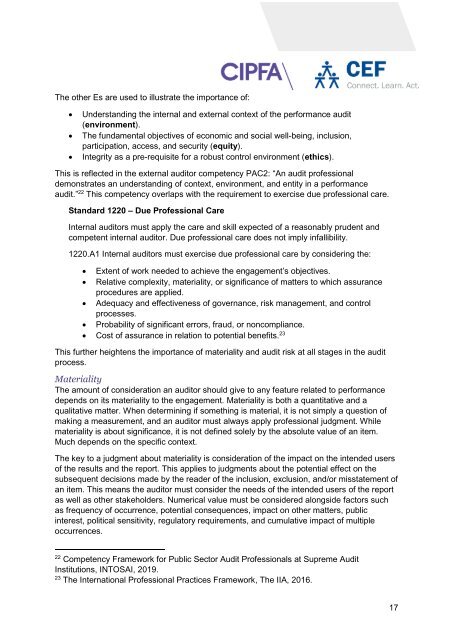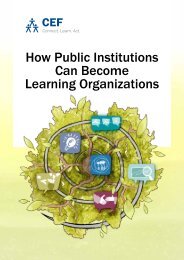You also want an ePaper? Increase the reach of your titles
YUMPU automatically turns print PDFs into web optimized ePapers that Google loves.
The other Es are used <strong>to</strong> illustrate the importance of:<br />
<br />
<br />
<br />
Understanding the internal and external context of the performance audit<br />
(environment).<br />
The fundamental objectives of economic and social well-being, inclusion,<br />
participation, access, and security (equity).<br />
Integrity as a pre-requisite for a robust control environment (ethics).<br />
This is reflected in the external audi<strong>to</strong>r competency PAC2: “An audit professional<br />
demonstrates an understanding of context, environment, and entity in a performance<br />
audit.” 22 This competency overlaps with the requirement <strong>to</strong> exercise due professional care.<br />
Standard 1220 – Due Professional Care<br />
Internal audi<strong>to</strong>rs must apply the care and skill expected of a reasonably prudent and<br />
competent internal audi<strong>to</strong>r. Due professional care does not imply infallibility.<br />
1220.A1 Internal audi<strong>to</strong>rs must exercise due professional care by considering the:<br />
Extent of work needed <strong>to</strong> achieve the engagement’s objectives.<br />
Relative complexity, materiality, or significance of matters <strong>to</strong> which assurance<br />
procedures are applied.<br />
Adequacy and effectiveness of governance, risk management, and control<br />
processes.<br />
Probability of significant errors, fraud, or noncompliance.<br />
Cost of assurance in relation <strong>to</strong> potential benefits. 23<br />
This further heightens the importance of materiality and audit risk at all stages in the audit<br />
process.<br />
Materiality<br />
The amount of consideration an audi<strong>to</strong>r should give <strong>to</strong> any feature related <strong>to</strong> performance<br />
depends on its materiality <strong>to</strong> the engagement. Materiality is both a quantitative and a<br />
qualitative matter. When determining if something is material, it is not simply a question of<br />
making a measurement, and an audi<strong>to</strong>r must always apply professional judgment. While<br />
materiality is about significance, it is not defined solely by the absolute value of an item.<br />
Much depends on the specific context.<br />
The key <strong>to</strong> a judgment about materiality is consideration of the impact on the intended users<br />
of the results and the report. This applies <strong>to</strong> judgments about the potential effect on the<br />
subsequent decisions made by the reader of the inclusion, exclusion, and/or misstatement of<br />
an item. This means the audi<strong>to</strong>r must consider the needs of the intended users of the report<br />
as well as other stakeholders. Numerical value must be considered alongside fac<strong>to</strong>rs such<br />
as frequency of occurrence, potential consequences, impact on other matters, public<br />
interest, political sensitivity, regula<strong>to</strong>ry requirements, and cumulative impact of multiple<br />
occurrences.<br />
22<br />
Competency Framework for Public Sec<strong>to</strong>r <strong>Audit</strong> Professionals at Supreme <strong>Audit</strong><br />
Institutions, INTOSAI, 2019.<br />
23<br />
The International Professional Practices Framework, The IIA, 2016.<br />
17
















